Learn about ONTAP data protection fan-out and cascade deployments
 Suggest changes
Suggest changes


You can use a fan-out deployment to extend data protection to multiple secondary systems. You can use a cascade deployment to extend data protection to tertiary systems.
Both fan-out and cascade deployments support any combination of SnapMirror DR, SnapVault, or unified replication. Beginning with ONTAP 9.5, SnapMirror synchronous relationships support fan-out deployments with one or more SnapMirror asynchronous relationships. Only one relationship in the fan-out configuration can be a SnapMirror synchronous relationship, all the other relationships from the source volume must be SnapMirror asynchronous relationships. SnapMirror synchronous relationships also support cascade deployments (beginning with ONTAP 9.6); however, the relationship from the destination volume of the SnapMirror synchronous relationship must be a SnapMirror asynchronous relationship. SnapMirror active sync (supported beginning with ONTAP 9.13.1) also supports fan-out configurations.

|
You can use a fan-in deployment to create data protection relationships between multiple primary systems and a single secondary system. Each relationship must use a different volume on the secondary system. |

|
You should be aware that volumes that are part of a fan-out or cascade configuration can take longer to resynchronize. It is not uncommon to see the SnapMirror relationship reporting the status "preparing" for an extended time period. |
How fan-out deployments work
SnapMirror supports multiple-mirrors and mirror-vault fan-out deployments.
A multiple-mirrors fan-out deployment consists of a source volume that has a mirror relationship to multiple secondary volumes.
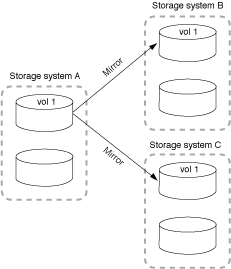
A mirror-vault fan-out deployment consists of a source volume that has a mirror relationship to a secondary volume and a SnapVault relationship to a different secondary volume.
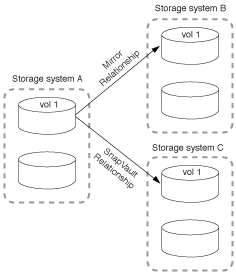
Beginning with ONTAP 9.5, you can have fan-out deployments with SnapMirror synchronous relationships; however, only one relationship in the fan-out configuration can be a SnapMirror synchronous relationship, all the other relationships from the source volume must be SnapMirror asynchronous relationships.
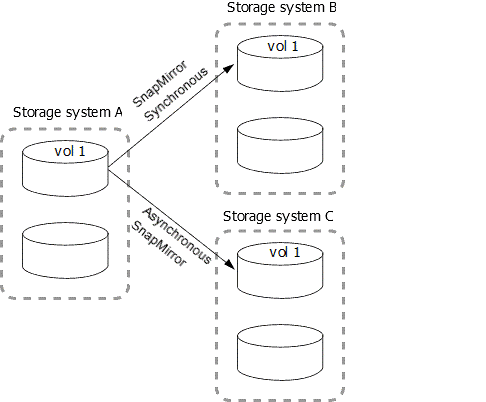
How cascade deployments work
SnapMirror supports mirror-mirror, mirror-vault, vault-mirror, and vault-vault cascade deployments.
A mirror-mirror cascade deployment consists of a chain of relationships in which a source volume is mirrored to a secondary volume, and the secondary volume is mirrored to a tertiary volume. If the secondary volume becomes unavailable, you can synchronize the relationship between the primary and tertiary volumes without performing a new baseline transfer.
In a relationship of cascaded volumes, long-term retention snapshots are supported only on the final SnapMirror destination volume of the cascade in all versions of ONTAP 9. Enabling long-term retention snapshots on any middle volume in the cascade results in missed backups and snapshots. If you have an unsupported configuration in which long-term retention snapshots have been enabled on any middle volume of a cascade, contact technical support and reference the NetApp Knowledge Base: Cascading a volume with Long-Term Retention (LTR) snapshots enabled is not supported for assistance.
The following ONTAP versions do not allow you to enable long-term retention snapshots on any volume in a cascade except the final SnapMirror destination volume.
-
9.15.1 and later
-
9.14.1P2 and P4 through P14
-
9.13.1P9 through P17
-
9.12.1 P12 through P19
-
9.11.1P15 through P20
-
9.10.1P18 through P20
-
9.9.1P20
Learn more about long-term retention snapshots.
Beginning with ONTAP 9.6, SnapMirror synchronous relationships are supported in a mirror-mirror cascade deployment. Only the primary and secondary volumes can be in a SnapMirror synchronous relationship. The relationship between the secondary volumes and tertiary volumes must be asynchronous.
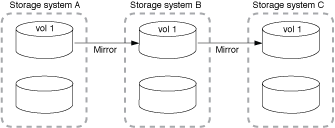
A mirror-vault cascade deployment consists of a chain of relationships in which a source volume is mirrored to a secondary volume, and the secondary volume is vaulted to a tertiary volume.
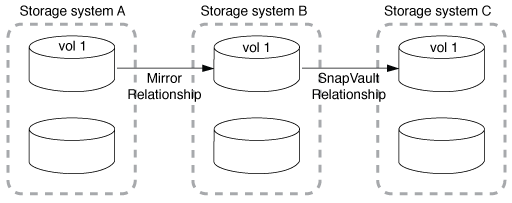
Vault-mirror and vault-vault cascade deployments are also supported:
-
A vault-mirror cascade deployment consists of a chain of relationships in which a source volume is vaulted to a secondary volume, and the secondary volume is mirrored to a tertiary volume.
-
A vault-vault cascade deployment consists of a chain of relationships in which a source volume is vaulted to a secondary volume, and the secondary volume is vaulted to a tertiary volume.


